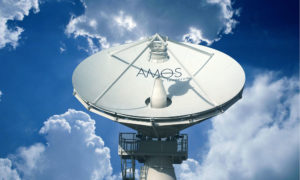
Israeli fleet operator Spacecom is very close to purchasing a new satellite, named AMOS-8. This forthcoming purchase is a sign of a turnaround for Spacecom, as well as a bet on the troubled company’s future.
Back-to-back spacecraft losses in 2015 and 2016 turned Spacecom from an expanding business into a struggling concern. Preceding the destruction of AMOS-6, Spacecom’s Russian-built AMOS-5 satellite ceased working in orbit due to a power system failure in 2015, just four years after its launch.
Because of this, what should have by now been a fully owned four-satellite fleet with margin for expansion is instead two fully owned satellites and a borrowed spacecraft. But purchasing this new satellite – AMOS-8 – would allow for the return of the borrowed satellite.
For the last year, Spacecom has borrowed ASIASAT-8 from Hong Kong operator AsiaSat as a gap-filler for AMOS-6, a large telecommunications satellite destroyed in SpaceX’s 2016 Falcon-9 pre-launch explosion. The loaner satellite costs Spacecom U.S.$22 million a year.
“This caused us to spend more money than we have anticipated,” said Jacob Keret, Spacecom’s senior vice president of sales and marketing for Europe, North Africa, and the Middle East, in comments made to Space News. “We are spearheading the process of selecting a vendor for the AMOS-8 satellite that we plan to launch at the end of 2020, about 30 months from now. I would assume that the vendor would be selected within the next months or six weeks.”
AMOS-8 will be smaller than AMOS-17, Keret said, and will carry Ku- and Ka-band capacity.
According to Keret, AMOS-17, a replacement for AMOS-5, remains on track for a 2019 SpaceX launch. Spacecom is using money paid toward the launch of AMOS-6 to launch AMOS-17, and it also intends to launch AMOS-8 with SpaceX.
Cobbett Hill Earth Station, a British teleport operator, signed a lease agreement in March 2018 for C-band capacity on AMOS-17, becoming the first customer on the satellite. Keret said Spacecom has the goal of pre-selling about 30 percent of the satellite’s capacity ahead of launch.
AMOS-17 will be located at 17 degrees east with coverage over Europe, Africa, the Middle East, and parts of Asia reaching to Western China. Boeing is building the satellite with C-, Ku-, and Ka-band transponders.
Keret told Space News that Africa is struggling with excess satellite communications capacity, but he argued that AMOS-17 will be differentiated enough to generate meaningful business. The Boeing-supplied digital payload enables “enormous” flexibility, he explained, including the ability to uplink in one frequency and downlink in another. This satellite will also have advanced interference-suppression capabilities, preventing stray signals and intentional jamming from disrupting communications.
Spacecom is watching the development of new broadband constellations in low Earth orbit, but views the cost of building such a network as too high to do so itself, Keret concluded, explaining that there is a high risk that many won’t succeed, but those that do are prospects for future partnerships.


